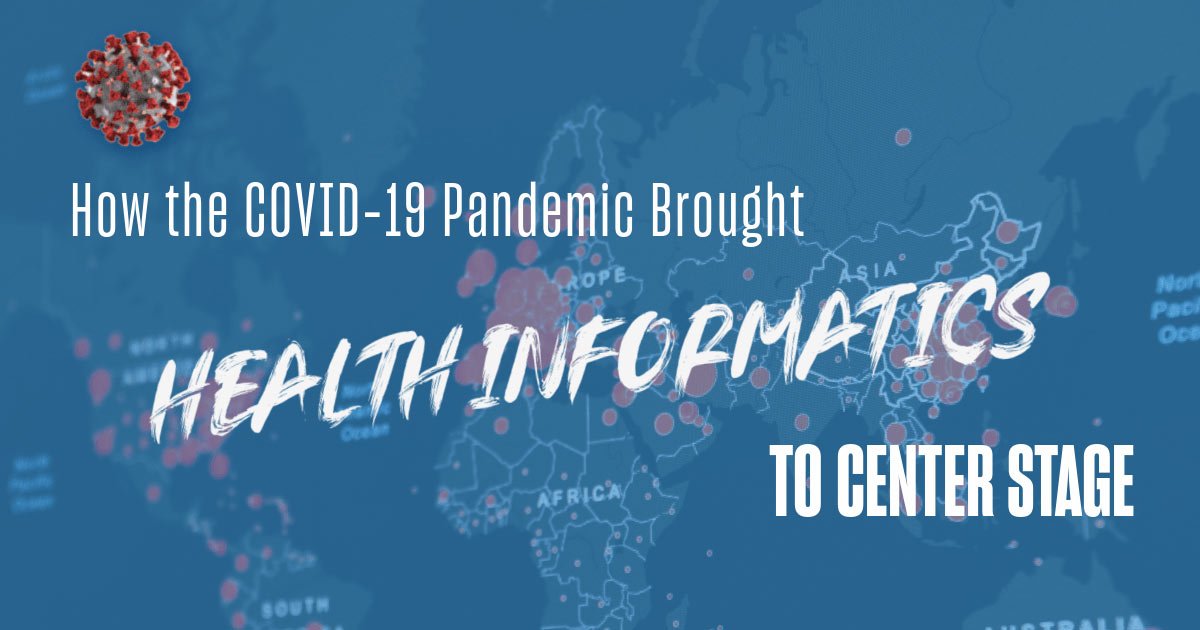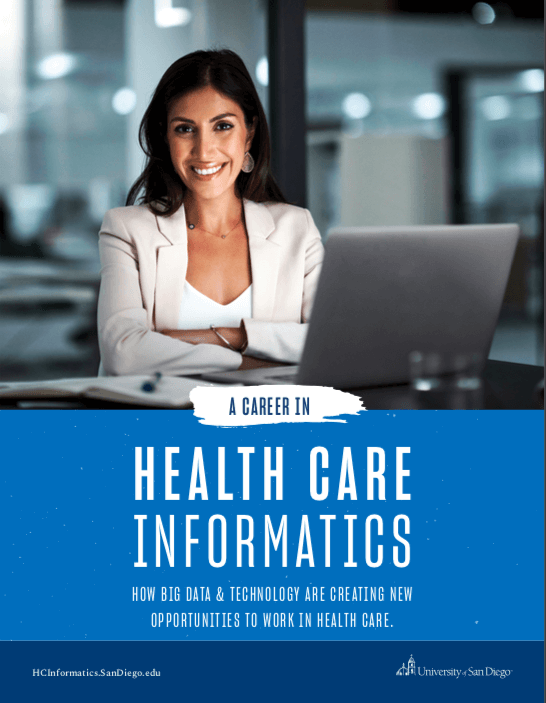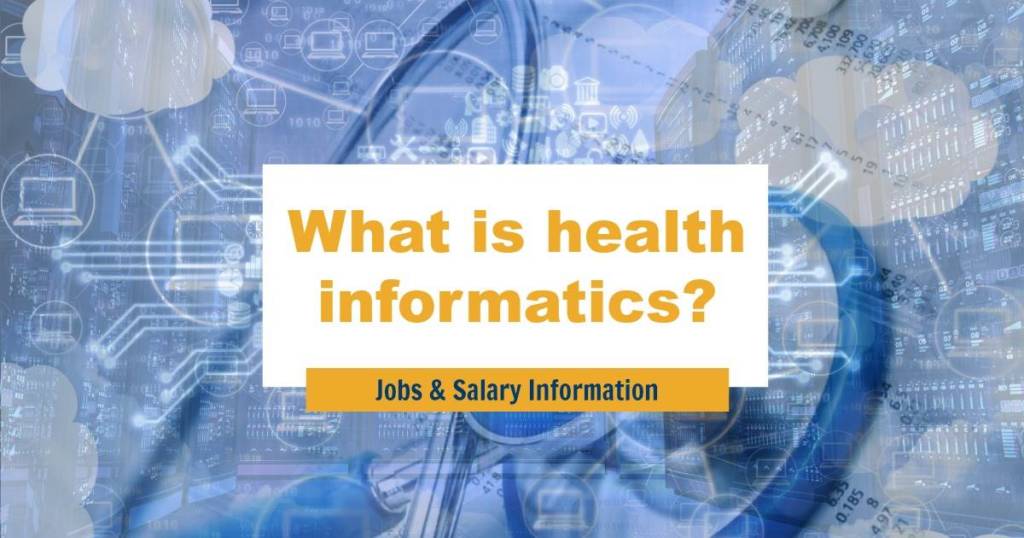Health informatics is one of the fastest growing fields of study and employment today. And while health informatics has been steadily growing in popularity and demand, its necessity was rapidly accelerated in the wake of the COVID-19 pandemic. “Never before has health informatics played a greater role in public health than during the COVID-19 pandemic,” according to industry website HITconsultant.net.
In the fight against COVID-19, researchers and physicians needed to develop solutions fast, using arguably their most valuable resource at the time — data. This is part of the inherent value of health informatics, both during a crisis and not: It can help generate insights quickly and accurately based on actual health care data, giving medical researchers and care providers additional tools and knowledge they wouldn’t have access to otherwise. So, as COVID-19 continued to spread, it became even more apparent just how critical health informatics is to medicine, and how it would help the medical field as a whole work to understand, predict, and contain the spread of this devastating virus.
How Health Informatics Helped in the Fight Against COVID-19
The pandemic underscored the opportunity and importance of the health informatics discipline, as demonstrated by the widespread utilization of health informatics applications like telehealth, remote patient monitoring, patient engagement, AI-based drug discovery, precision medicine and clinical decision support. To put it plainly, health informatics proved to be integral to the pandemic response, as a discipline that leveraged the best assets of predictive analytics, big data and health care.
Although the pandemic is not over, the outcomes and insights derived from many COVID-19 health informatics initiatives will continue to impact and benefit care for years to come. And while there are dozens of examples of how researchers and physicians used health informatics tools and principles during this time, here is a collection of some of the most impactful innovations.
- Artificial Intelligence Helped Researchers Understand COVID-19 Virus Structure
Quick summary: In the early days of the pandemic, Google’s artificial intelligence research lab DeepMind was able to use deep learning to predict the structure of proteins associated with SARS-CoV-2, the virus that causes COVID-19. By understanding the makeup of the virus, providers could better formulate potential treatment options that would return the most optimal results.
Excerpts from the full report, published on DeepMind.com: “Labs at the forefront of the outbreak response shared genomes of the virus in open access databases, which enabled researchers to rapidly develop tests for this novel pathogen. Other labs have shared experimentally-determined and computationally-predicted structures of some of the viral proteins, and still others have shared epidemiological data.
“Knowing a protein’s structure provides an important resource for understanding how it functions, but experiments to determine the structure can take months or longer, and some prove to be intractable. For this reason, researchers have been developing computational methods to predict protein structure from the amino acid sequence. In cases where the structure of a similar protein has already been experimentally determined, algorithms based on “template modelling” are able to provide accurate predictions of the protein structure. “AlphaFold, our recently published deep learning system, focuses on predicting protein structure accurately when no structures of similar proteins are available, called ‘free modeling.’”
- Data Visualization Platforms Helped Track COVID-19 Spread
Quick Summary: On January 22, 2020, before the world knew the full scope and impact of the COVID-19 outbreak, Johns Hopkins University started compiling data to help keep track of information related to the outbreak. To assist with all facets of medical care and research, the Johns Hopkins team created and shared an interactive dashboard that tracked real-time data on confirmed coronavirus cases, recoveries and deaths.
Excerpts from the full article, published on Health IT Analytics: “The Center for Systems Science and Engineering (CSSE) at Johns Hopkins University developed an interactive, web-based dashboard that tracks real-time data on confirmed coronavirus cases, deaths, and recoveries for all affected countries.
“The dashboard was created to offer providers, public health authorities, researchers, and the general public a user-friendly tool to track the outbreak. All data collected and displayed is made freely available, initially as Google Sheets but now in a GitHub repository, along with the feature layers of the dashboard.
“Every 15 minutes, DXY updates the cumulative case counts for all provinces in China as well as other affected countries and regions. For regions and countries outside mainland China, such as Hong Kong, Taiwan, and Macau, CSSE manually updates case numbers throughout the day when new cases are identified.”
- Machine Learning Was Used to Forecast Quarantine Impacts
Quick Summary: A research team from the Massachusetts Institute of Technology (MIT) developed a machine learning model that used coronavirus data and a neural network to determine the effectiveness of quarantine measures and predict the spread of the virus. This was critical in the early days of the pandemic.
Excerpts from the full article, published on Health IT Analytics: “Using the machine learning algorithm, researchers forecasted that with the quarantine measures in place during the spring, the plateau for Italy and the U.S. would arrive somewhere between April 15-20. The model also suggested that the infection count would reach 600,000 in the U.S. before the rate of infection starts to stagnate.
“Our model shows that quarantine restrictions are successful in getting the effective reproduction number from larger than one to smaller than one. That corresponds to the point where we can flatten the curve and start seeing fewer infections,” said George Barbastathis, professor of mechanical engineering.”
- Health Informatics Helped Monitor Hospital Capacity & Forecast Surges
Quick Summary: Definitive Healthcare, a health care data and analytics company, partnered with a global geographic information systems company to create an interactive platform to identify places with low hospital bed capacity due to COVID-19. A second research team from Penn Medicine developed a tool that helped forecast the next hospitals and areas that would likely experience bed shortages and would have the most critical need.
Excerpts from the full report, published on Health IT Analytics: “Definitive Healthcare and ESRI designed these resources to provide researchers, public health authorities, and the public with user-friendly information to help identify geographic areas of risk, or places with a low capacity to accommodate sick patients.
“In the dashboard, Definitive Healthcare’s data and intelligence is spatially enabled by ESRI’s Geospatial Cloud, accurately showing where in the US, and at which hospitals, additional beds could be accommodated.
“As the COVID-19 virus spreads in the US and around the world, public health providers and other types of responders have been trying to understand which areas may require the greatest amount of aid. We built this geographic map of US hospital bed utilization and capacity to solve some of these challenges,” said Este Geraghty, ESRI’s Chief Medical Officer.”
- AI Was Used to Identify Asymptomatic Carriers Based on Their Cough
Quick Summary: Researchers at MIT were able to leverage an artificial intelligence tool that uses voice modeling to detect the differences between the coughs of healthy individuals and asymptomatic people with COVID-19 infections.
Excerpts from the full report, published in the IEEE Journal of Engineering in Medicine and Biology: “When validated with subjects diagnosed using an official test, the model achieves COVID-19 sensitivity of 98.5% with a specificity of 94.2% (AUC: 0.97). For asymptomatic subjects it achieves sensitivity of 100% with a specificity of 83.2%.
“AI techniques can produce a free, non-invasive, real-time, any-time, instantly distributable, large-scale COVID-19 asymptomatic screening tool to augment current approaches in containing the spread of COVID-19.”
- Big Data Helped Calculate COVID-19 Mortality Risk & Shape the Vaccine Distribution Plan
Quick Summary: Researchers from Johns Hopkins Bloomberg School of Public Health used big data analytics to develop a COVID-19 mortality risk calculator, a tool that partially influenced the COVID-19 vaccine distribution plan.
Full Study Published in Nature Medicine: “Reducing COVID-19 burden for populations will require equitable and effective risk-based allocations of scarce preventive resources, including vaccinations1. To aid in this effort, we developed a general population risk calculator for COVID-19 mortality based on various sociodemographic factors and pre-existing conditions for the US population, combining information from the UK-based OpenSAFELY study with mortality rates by age and ethnicity across US states.
“Projections show that the model can identify relatively small fractions of the population (for example 4.3%) that might experience a disproportionately large number of deaths (for example 48.7%), but there is wide variation in risk across communities. We provide a web-based risk calculator and interactive maps for viewing community-level risks.”
What a Growing Health Informatics Industry Means for You
For many of those working in or considering entering the field of health informatics, one of the motivations can be the opportunity to do important work that advances human health. And given the proven benefits of AI, machine learning and data analytics applications in the field, the need for health informaticists will undoubtedly continue to skyrocket.
One of the best ways to transition into a health informatics career is to pursue a master’s degree in health care informatics. Whether one currently works in a health care setting or has experience in a different industry and is looking to transition to a career in health care informatics, a health informatics master’s degree will equip anyone with the skills, knowledge and tools to be successful in the field. And for those especially interested in the analytics tools mentioned in these studies, there are master’s programs like the MS in Health Informatics at University of San Diego that allow students to choose specialized health data analytics coursework to further explore these topics and develop the foundation required for this important work.





